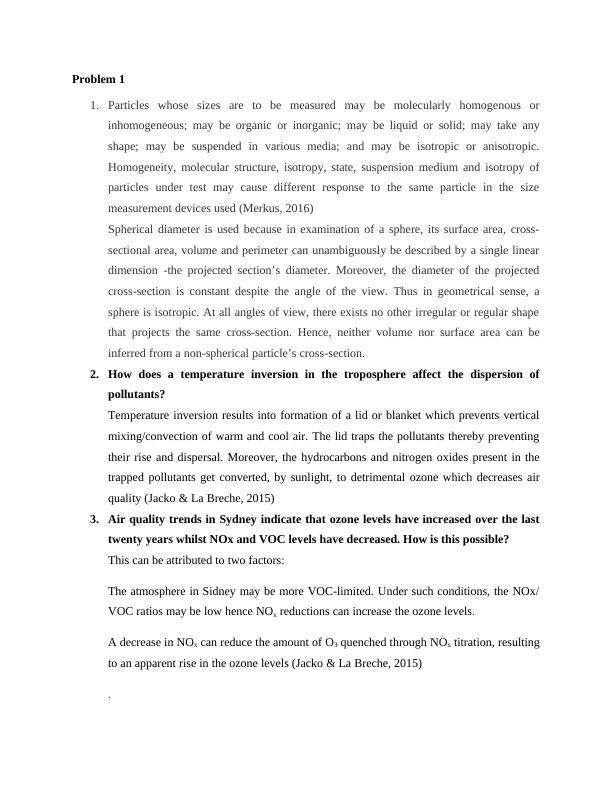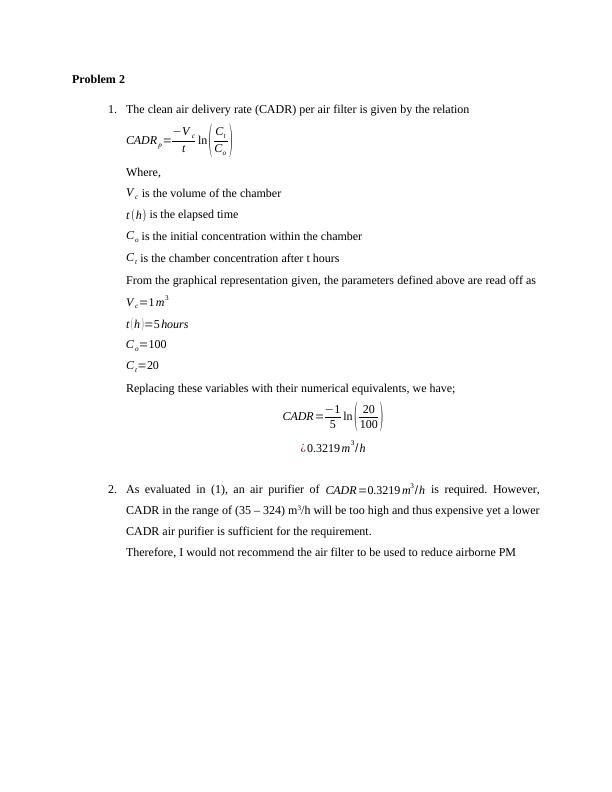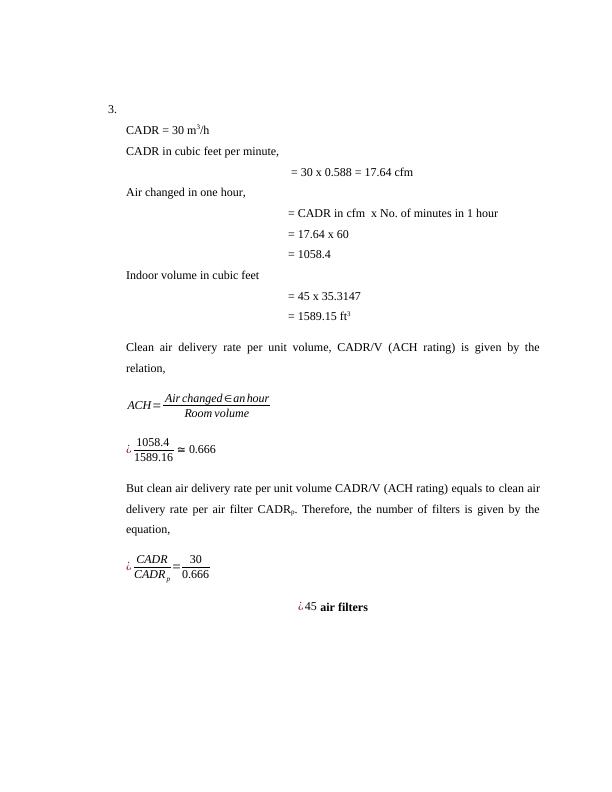Physics - CADR | Question and Answer
Added on 2022-08-25
6 Pages823 Words34 Views
Problem 1
1. Particles whose sizes are to be measured may be molecularly homogenous or
inhomogeneous; may be organic or inorganic; may be liquid or solid; may take any
shape; may be suspended in various media; and may be isotropic or anisotropic.
Homogeneity, molecular structure, isotropy, state, suspension medium and isotropy of
particles under test may cause different response to the same particle in the size
measurement devices used (Merkus, 2016)
Spherical diameter is used because in examination of a sphere, its surface area, cross-
sectional area, volume and perimeter can unambiguously be described by a single linear
dimension -the projected section’s diameter. Moreover, the diameter of the projected
cross-section is constant despite the angle of the view. Thus in geometrical sense, a
sphere is isotropic. At all angles of view, there exists no other irregular or regular shape
that projects the same cross-section. Hence, neither volume nor surface area can be
inferred from a non-spherical particle’s cross-section.
2. How does a temperature inversion in the troposphere affect the dispersion of
pollutants?
Temperature inversion results into formation of a lid or blanket which prevents vertical
mixing/convection of warm and cool air. The lid traps the pollutants thereby preventing
their rise and dispersal. Moreover, the hydrocarbons and nitrogen oxides present in the
trapped pollutants get converted, by sunlight, to detrimental ozone which decreases air
quality (Jacko & La Breche, 2015)
3. Air quality trends in Sydney indicate that ozone levels have increased over the last
twenty years whilst NOx and VOC levels have decreased. How is this possible?
This can be attributed to two factors:
The atmosphere in Sidney may be more VOC-limited. Under such conditions, the NOx/
VOC ratios may be low hence NOx reductions can increase the ozone levels.
A decrease in NOx can reduce the amount of O3 quenched through NOx titration, resulting
to an apparent rise in the ozone levels (Jacko & La Breche, 2015)
.
1. Particles whose sizes are to be measured may be molecularly homogenous or
inhomogeneous; may be organic or inorganic; may be liquid or solid; may take any
shape; may be suspended in various media; and may be isotropic or anisotropic.
Homogeneity, molecular structure, isotropy, state, suspension medium and isotropy of
particles under test may cause different response to the same particle in the size
measurement devices used (Merkus, 2016)
Spherical diameter is used because in examination of a sphere, its surface area, cross-
sectional area, volume and perimeter can unambiguously be described by a single linear
dimension -the projected section’s diameter. Moreover, the diameter of the projected
cross-section is constant despite the angle of the view. Thus in geometrical sense, a
sphere is isotropic. At all angles of view, there exists no other irregular or regular shape
that projects the same cross-section. Hence, neither volume nor surface area can be
inferred from a non-spherical particle’s cross-section.
2. How does a temperature inversion in the troposphere affect the dispersion of
pollutants?
Temperature inversion results into formation of a lid or blanket which prevents vertical
mixing/convection of warm and cool air. The lid traps the pollutants thereby preventing
their rise and dispersal. Moreover, the hydrocarbons and nitrogen oxides present in the
trapped pollutants get converted, by sunlight, to detrimental ozone which decreases air
quality (Jacko & La Breche, 2015)
3. Air quality trends in Sydney indicate that ozone levels have increased over the last
twenty years whilst NOx and VOC levels have decreased. How is this possible?
This can be attributed to two factors:
The atmosphere in Sidney may be more VOC-limited. Under such conditions, the NOx/
VOC ratios may be low hence NOx reductions can increase the ozone levels.
A decrease in NOx can reduce the amount of O3 quenched through NOx titration, resulting
to an apparent rise in the ozone levels (Jacko & La Breche, 2015)
.

Problem 2
1. The clean air delivery rate (CADR) per air filter is given by the relation
CADRp =−V c
t ln ( Ct
Co )
Where,
V c is the volume of the chamber
t (h) is the elapsed time
Co is the initial concentration within the chamber
Ct is the chamber concentration after t hours
From the graphical representation given, the parameters defined above are read off as
V c=1 m3
t ( h )=5 hours
Co=100
Ct=20
Replacing these variables with their numerical equivalents, we have;
CADR=−1
5 ln ( 20
100 )
¿ 0.3219 m3 /h
2. As evaluated in (1), an air purifier of CADR=0.3219 m3 /h is required. However,
CADR in the range of (35 – 324) m3/h will be too high and thus expensive yet a lower
CADR air purifier is sufficient for the requirement.
Therefore, I would not recommend the air filter to be used to reduce airborne PM
1. The clean air delivery rate (CADR) per air filter is given by the relation
CADRp =−V c
t ln ( Ct
Co )
Where,
V c is the volume of the chamber
t (h) is the elapsed time
Co is the initial concentration within the chamber
Ct is the chamber concentration after t hours
From the graphical representation given, the parameters defined above are read off as
V c=1 m3
t ( h )=5 hours
Co=100
Ct=20
Replacing these variables with their numerical equivalents, we have;
CADR=−1
5 ln ( 20
100 )
¿ 0.3219 m3 /h
2. As evaluated in (1), an air purifier of CADR=0.3219 m3 /h is required. However,
CADR in the range of (35 – 324) m3/h will be too high and thus expensive yet a lower
CADR air purifier is sufficient for the requirement.
Therefore, I would not recommend the air filter to be used to reduce airborne PM

3.
CADR = 30 m3/h
CADR in cubic feet per minute,
= 30 x 0.588 = 17.64 cfm
Air changed in one hour,
= CADR in cfm x No. of minutes in 1 hour
= 17.64 x 60
= 1058.4
Indoor volume in cubic feet
= 45 x 35.3147
= 1589.15 ft3
Clean air delivery rate per unit volume, CADR/V (ACH rating) is given by the
relation,
ACH= Air changed ∈an hour
Room volume
¿ 1058.4
1589.16 ≅ 0.666
But clean air delivery rate per unit volume CADR/V (ACH rating) equals to clean air
delivery rate per air filter CADRp. Therefore, the number of filters is given by the
equation,
¿ CADR
CADRp
= 30
0.666
¿ 45 air filters
CADR = 30 m3/h
CADR in cubic feet per minute,
= 30 x 0.588 = 17.64 cfm
Air changed in one hour,
= CADR in cfm x No. of minutes in 1 hour
= 17.64 x 60
= 1058.4
Indoor volume in cubic feet
= 45 x 35.3147
= 1589.15 ft3
Clean air delivery rate per unit volume, CADR/V (ACH rating) is given by the
relation,
ACH= Air changed ∈an hour
Room volume
¿ 1058.4
1589.16 ≅ 0.666
But clean air delivery rate per unit volume CADR/V (ACH rating) equals to clean air
delivery rate per air filter CADRp. Therefore, the number of filters is given by the
equation,
¿ CADR
CADRp
= 30
0.666
¿ 45 air filters

End of preview
Want to access all the pages? Upload your documents or become a member.
